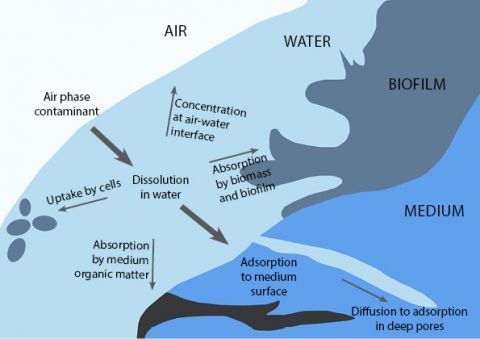How does a biofilter work?
How does a biofilter work?
For removing odour components, combating VOCs and treating naturally occurring solvents, we recommend air treatment using a biofilter. In the case of solvents, the air stream to be treated is guided through a filter bed. In contrast to an active carbon filter, for example, the solvents are absorbed in the water film and processed by the microorganisms into biomass, water and possibly a few acids.
Biofilters are an efficient solution for the removal of biodegradable components. The technique is mainly applicable at lower, stable concentrations and flow rates. Moreover, it is an economical method, both in terms of investment and operational cost.
Since different microorganisms have different specialties and therefore also process different components, a new selection of microorganisms must be chosen for each type of biofilter. This way we achieve the maximum efficiency of the biofilter. However, the selected bacteria cannot survive solely on solvents and/or odour components. They also need their supplements or "vitamins". This mix of "vitamins" is also important to maintain the necessary bacteria in the filter.
We do pilot tests to dimension the biofilter correctly. During these tests, we examine how many solvents/components the bacteria can process. This depends on the project because of the ever varying composition of the air and their influence on the functioning of microorganisms.
Important parameters
Flow rate and loading of the biofilter
The proper functioning of a biofilter requires a as stable as possible flow rate and load. The microorganisms are sensitive to low concentrations because they do not have enough "food" (read solvents/contaminants) to survive. On the other hand, if there is an excess of "food", they produce too much biomass, which increases the pressure loss over the filter. Moreover, at a higher concentration not all solvents will be absorbed by the biofilter. Since the biofilter uses microorganisms, it can eventually adapt to small changes in flow and concentration, but this takes time.
The duration of which the gas has to stay inside the biofilter, must be at least 30-45 seconds to get a good result.
Temperature
Just like humans, microorganisms need a certain temperature to perform their normal function. The temperature of the biofilter should be between 15 and 30°C. This is an important variable to keep the efficiency on point.
Humidity
The humidity parameter includes both the humidity of the incoming air stream and the humidity of the biofilter itself. Both should ensure that there is enough water in the biofilter, so that the water film around the carrier material is large enough. In addition, sufficient water is also needed to remove formed acids and salts.
pH
For decomposition of organic components, the pH should be between 7 and 8. When the biofilter is acidified, the efficiency drops. However, there are also exceptions regarding the pH of the biofilter.
Carrier material
To form a good biofilm, a good carrier material is needed. On the one hand, the carrier material provides nutrients for the microorganisms. On the other hand, it forms a hold for the organisms.
Maintenance
For the maintenance of the biofilter, we recommend monitoring the pressure loss over the biofilter and performing a periodic analysis of the bacteria and pH present. Good maintenance ensures a better durability of the biofilter.
Typical components to be treated
- H2S
- Odeur components
- MEK
- Methoxypropanol
- BTEX
- Naturally formed solvents
Balancing pros and cons
Like any other system, the biofilter has some disadvantages. For example, the installation is quite large and you need a constant waste stream (both in terms of flow and concentration of solvents). Moreover, the installation is sensitive to dust and the pH values must be checked regularly. Finally, we are also talking about living organisms, which is why a pilot test is highly recommended.
However, these disadvantages do not outweigh the advantages. The maintenance costs of a biofilter are very low compared to similar solutions. In adsorption processes, for example, these maintenance costs can increase due to replacement of the activated carbon and/or sorbent. In addition, compared to thermal oxidation, no additional gas/electricity is needed for such low concentrations. The biofilter breaks down the waste in a biological way and produces less wastewater than, for example, a gas scrubber. It is a very efficient and effective way to treat odours from the air. Finally, you can count on a very thorough removal of biodegradable components.
Does your production suffer from odour components? Do you want to fight VOCs? Or are you looking for a way to treat naturally occurring solvents? Or do you wish to further optimise your biofilter? Contact us now and we will be happy to help you!


